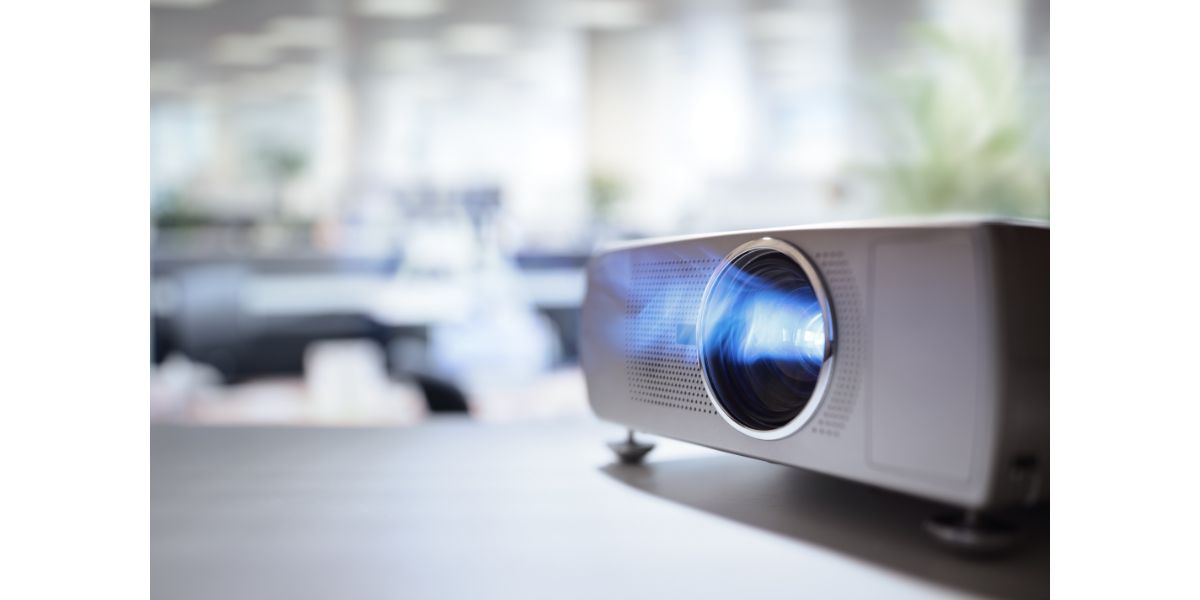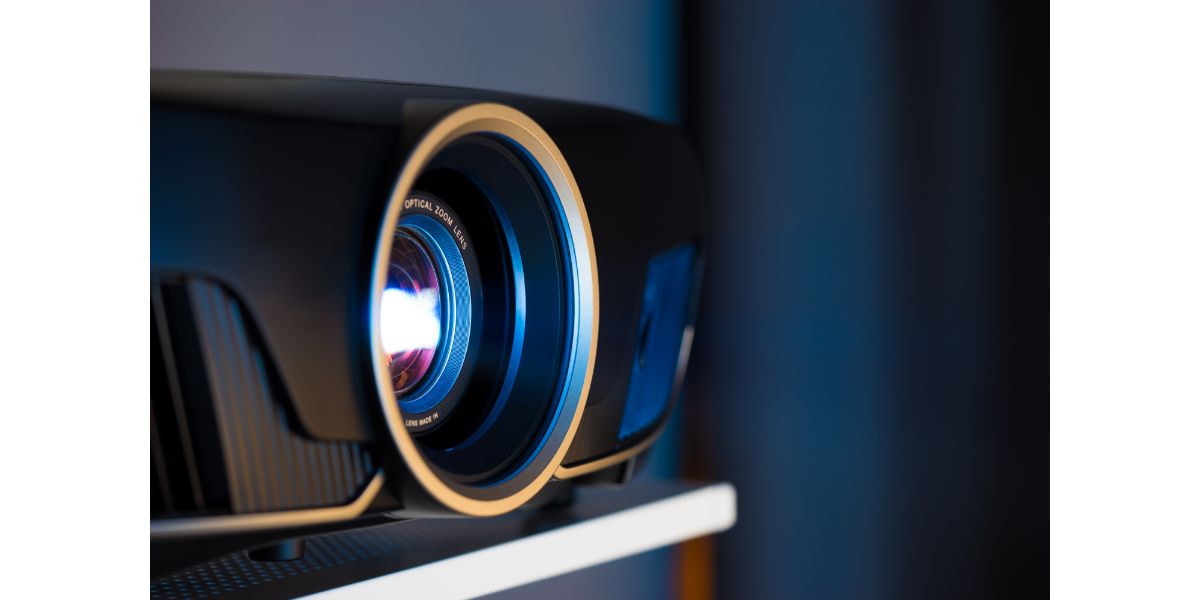Disclaimer: This post may contain affiliate links, meaning we get a small commission if you make a purchase through our links, at no cost to you. For more information, please visit our Disclaimer Page.
Technology is improving every year, so projectors are not as likely to get burn-in as they once were. Even so, you could still get burn-in if you leave your LCD projector on for hours and days at a time. This guide will cover all you need to know about what projector burn-in is, when it happens, if it’s fixable, and how to avoid it.
Table of Contents
What Is Projector Burn-In?
Projector burn-in is also called image persistence, image retention, a sticking image, or a ghost image. A few of these terms are actually distinct, but we’ll discuss that below.
Burn-in is when a fixed image is projected for a long time, causing the polarization of materials within the LCD panel. This causes the image to be “burned” on the screen. These images are usually blurry versions of the original.
Unfortunately, projector burn-in is permanent and virtually impossible to fix. It could ruin your projector and cost you a chunk of change to replace the affected parts.
The Difference Between Burn-In and Image Retention
While they are often used interchangeably, burn-in and image retention are different.
Both situations occur when you have the same display showing for a long time. Electrodes are moved by the electric charge, causing the liquid crystals within the projector to build up and leave a mark. Burn-in is a type of image retention, but not all image retention is burn-in.
Here are some key differences.
- Burn-in is persistent and permanent, whereas image retention may disappear over time.
- You’ll need to replace a part of your projector to fix burn-in, whereas image retention usually goes away on its own
- Burn-in takes maintenance, while image retention does not
How to Identify Burn-In
Burn-in will usually manifest as a discolored visual with dark brown, black, or yellow spots. The longer the image has been projected, the darker the spots may be. If you see these spots on various images and your projector is less than a year old, it may be a defective or bad lens instead of a burn-in.
How to Avoid Burn-In
Maintaining your projector clean, turning it off when it’s not in use, adjusting its position, and adjusting the sleep mode settings is the best way to avoid burn-in and extend the life of your device.
1. Keep It Clean
It’s important to clean your projector’s lens, air filter, and air vents to prevent overheating and burn-in and to keep your device in tip-top shape.
First, power off your device and unplug the cord. To clean the lens, use compressed air to remove dust and a lens-cleaning paper or moist soft cloth with lens cleaner to wipe the surface.
To clean the outside of the projector, use a vacuum with a soft brush attachment for the vents.
Over time, you may also have to clean the lamp vent screens. Use your owner’s manual to remove the lamp and do not touch the glass at the front of the lamp. Locate the lamp screens and use a vacuum with a crevice attachment to clean any buildup or blockage.
2. Turn It Off
The most important way to avoid burn-in is by turning your projector off when not in use. Be sure your projector’s sleep mode or screensaver mode is activated after a short period of inactivity. Many projectors come with a built-in power-saving mode, while others will need to be selected in settings.
3. Adjust the Settings
All projectors will come with a manual that describes how to change the settings. Typically, you’ll select the menu button on the panel or remote and be able to select a “Standby,” “Sleep,” or “Eco” option. Most of these put the projector to sleep after a set time of inactivity. Some projectors will let you choose the time frame.
4. Adjust Your Projector’s Position
To make sure everything is in its place, unplug, organize, and re-plug all of the cables connected to your projector. Make sure none are frayed, damaged, or overheated.
Also, keep your projector somewhere where it doesn’t rub against other electronics to ensure airflow.
How to Fix Burn-In
If you think your projector has burn-in, you’ll have to do a quick inspection to confirm that is the case. If it checks out, you’ll need to replace the polarizer, color wheel, or your projector as a whole.
1. Check the Screen
It’s important to identify that the image issue is from your projector and not your screen. If you turn off your projector, you should be able to see if any of the spots remain on the screen. If so, it is a screen issue.
2. Check the Lens
Next, inspect your lens. Complete a cleaning to see if the dark spots or blurry image disappears. Since this may be image retention instead of burn-in, leave the projector off for a few hours and see if the image recedes.
3. Replace the Polarizer or Color Wheel
If you confirm your projector has burn-in, you’ll have to replace the projector’s polarizer, color wheel, and/or other parts to get it back to working condition. Some do-it-yourself (DIY) guides are out there to help get this done, or you can take it to a tech repair shop.
Sometimes, the replacement cost may be equal to the price of buying a new projector.
FAQ:
Why does my projector have burn-in?
Projectors get burn-in when a still image is projected for extended periods. This mostly happens with LCD panels containing a liquid crystal material that helps display images. When the projector is on for a long time, the liquid crystals polarize and make the image get stuck, or burned on, the lens.
How do you get rid of screen burn on a projector?
If the blurriness or smeared image can be cleaned off, it is just image retention and can also go away. If it doesn’t go away, it is burn-in, which is permanent. You’ll need to replace parts of your projector or buy a new one.
Do projectors burn out?
All projectors have a bulb or lamp that will eventually need to be replaced. Most will last at least a couple thousand hours, though, so this won’t happen too often.
How do I stop my screen from burning?
The best way to stop your screen from burning is to make sure your projector goes to “Eco,” “Standby,” or “Sleep” mode after a set time of inactivity. Be sure to also maintain and clean your projector regularly. Ensure airflow and avoid overheating by positioning it somewhere other devices do not block it.
Final Thoughts
Projectors can turn any room into a cinema or the ultimate gaming experience but, like with any device, they require maintenance to stay in shape. If you leave your projector on a still image for too long, the image could “burn” into the projector, known as burn in.
So long as you keep your projector clean and up to date and turn it on standby, sleep, or eco mode when not in use, you should be able to avoid burn in altogether.


